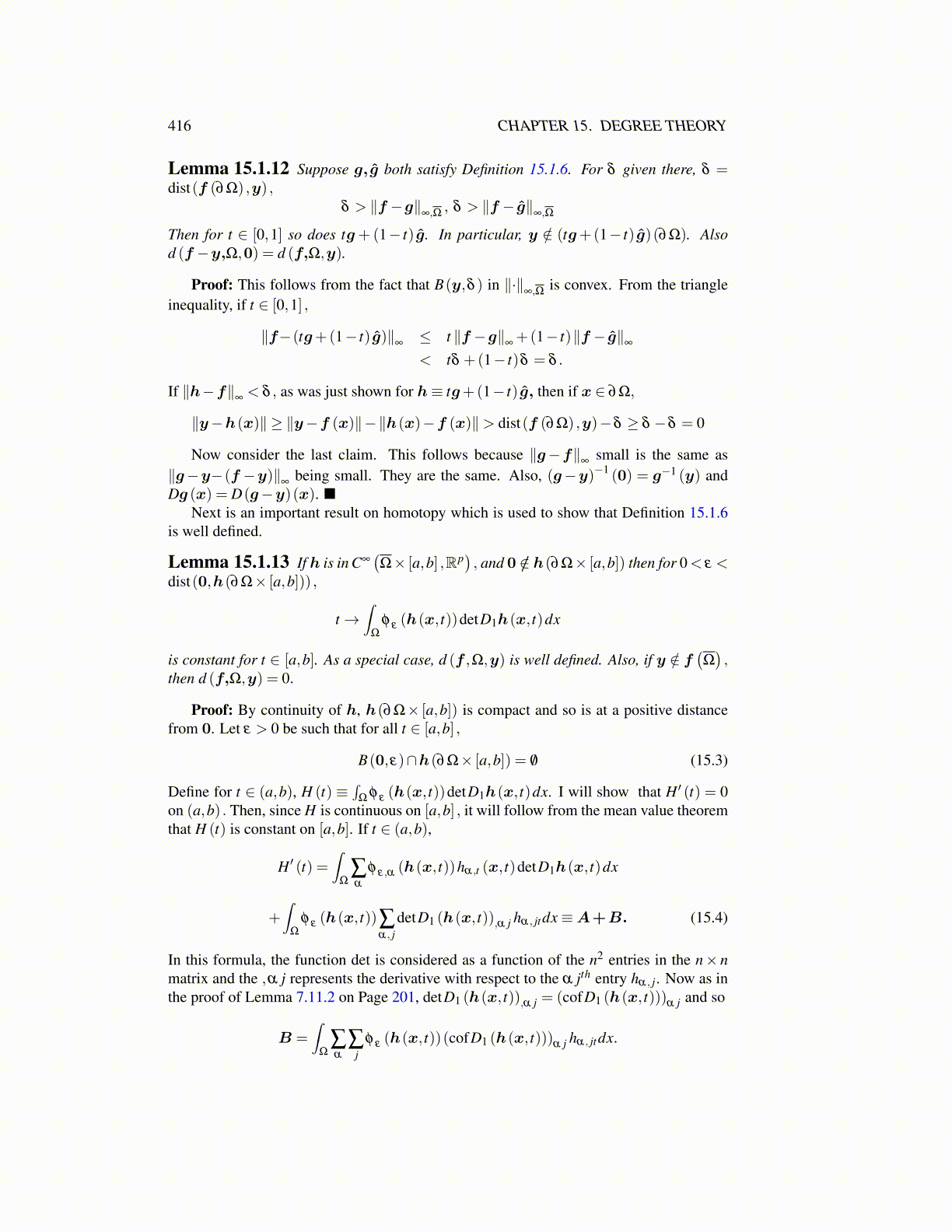
416 CHAPTER 15. DEGREE THEORY
Lemma 15.1.12 Suppose g, ĝ both satisfy Definition 15.1.6. For δ given there, δ =dist(f (∂Ω) ,y) ,
δ > ∥f −g∥∞,Ω , δ > ∥f − ĝ∥
∞,Ω
Then for t ∈ [0,1] so does tg+ (1− t) ĝ. In particular, y /∈ (tg+(1− t) ĝ)(∂Ω). Alsod (f −y,Ω,0) = d (f,Ω,y).
Proof: This follows from the fact that B(y,δ ) in ∥·∥∞,Ω is convex. From the triangle
inequality, if t ∈ [0,1] ,
∥f−(tg+(1− t) ĝ)∥∞≤ t ∥f −g∥
∞+(1− t)∥f − ĝ∥
∞
< tδ +(1− t)δ = δ .
If ∥h−f∥∞< δ , as was just shown for h≡ tg+(1− t) ĝ, then if x ∈ ∂Ω,
∥y−h(x)∥ ≥ ∥y−f (x)∥−∥h(x)−f (x)∥> dist(f (∂Ω) ,y)−δ ≥ δ −δ = 0
Now consider the last claim. This follows because ∥g−f∥∞
small is the same as∥g−y−(f −y)∥
∞being small. They are the same. Also, (g−y)−1 (0) = g−1 (y) and
Dg (x) = D(g−y)(x). ■Next is an important result on homotopy which is used to show that Definition 15.1.6
is well defined.
Lemma 15.1.13 If h is in C∞(Ω× [a,b] ,Rp
), and 0 /∈ h(∂Ω× [a,b]) then for 0< ε <
dist(0,h(∂Ω× [a,b])) ,
t→∫
Ω
φ ε (h(x, t))detD1h(x, t)dx
is constant for t ∈ [a,b]. As a special case, d (f ,Ω,y) is well defined. Also, if y /∈ f(Ω),
then d (f,Ω,y) = 0.
Proof: By continuity of h, h(∂Ω× [a,b]) is compact and so is at a positive distancefrom 0. Let ε > 0 be such that for all t ∈ [a,b] ,
B(0,ε)∩h(∂Ω× [a,b]) = /0 (15.3)
Define for t ∈ (a,b), H (t) ≡∫
Ωφ ε (h(x, t))detD1h(x, t)dx. I will show that H ′ (t) = 0
on (a,b) . Then, since H is continuous on [a,b] , it will follow from the mean value theoremthat H (t) is constant on [a,b]. If t ∈ (a,b),
H ′ (t) =∫
Ω∑α
φ ε,α (h(x, t))hα,t (x, t)detD1h(x, t)dx
+∫
Ω
φ ε (h(x, t))∑α, j
detD1 (h(x, t)),α j hα, jtdx≡A+B. (15.4)
In this formula, the function det is considered as a function of the n2 entries in the n× nmatrix and the ,α j represents the derivative with respect to the α jth entry hα, j. Now as inthe proof of Lemma 7.11.2 on Page 201, detD1 (h(x, t)),α j = (cofD1 (h(x, t)))α j and so
B =∫
Ω∑α
∑j
φ ε (h(x, t))(cofD1 (h(x, t)))α j hα, jtdx.